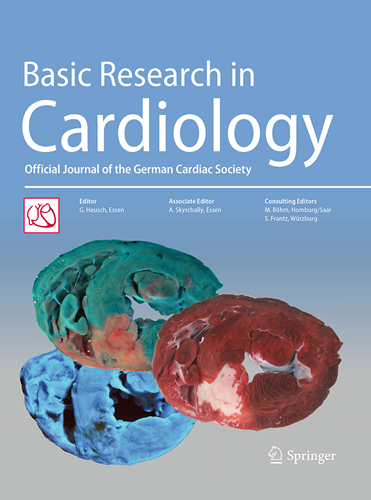高原适应降低心肌梗死的新机制:抑制炎症诱导的BKCa泛素降解,增强冠状动脉舒张。
IF 8
1区 医学
Q1 CARDIAC & CARDIOVASCULAR SYSTEMS
引用次数: 0
摘要
我们之前的研究表明,慢性间歇低氧(CIHH)预处理对大鼠缺血/再灌注(I/R)损伤具有心脏保护作用。然而,CIHH的心脏保护作用的确切机制仍然没有得到充分的了解。本研究旨在阐明BKCa通道在cihh诱导的大鼠冠状动脉血管扩张中介导心脏保护的上游信号通路和动态调控。雄性Sprague-Dawley大鼠按年龄和体重匹配,分为对照组(Con)和CIHH组。CIHH组接受模拟海拔4000米的低气压缺氧暴露35天,每天5小时。分离心脏,用Langendorff系统灌注,缺血30分钟,然后再灌注60或120分钟。与对照组相比,CIHH显著改善了左心室功能恢复,减少了梗死面积,增加了冠状动脉血流(CF)。微血管记录、共免疫沉淀和全细胞膜片钳技术表明,CIHH通过促进冠状动脉血管舒张来增强CF,这归因于肌肉无名指蛋白-1 (MuRF1)介导的BKCa-β1亚基降解的抑制。此外,CIHH抑制ikk α诱导的i -κB α磷酸化和泛素介导的i -κB α降解,从而增强其在冠状动脉平滑肌细胞中与NF-κB p65的细胞质结合。这一过程减弱了NF-κB p65核易位和随后炎症诱导的MuRF1表达。通过抑制NF-κB/ murf1介导的BKCa-β1降解,观察到冠状动脉舒张的增加,有助于CIHH后CF的增强和对I/R损伤的心脏保护。本文章由计算机程序翻译,如有差异,请以英文原文为准。
A new mechanism of high-altitude adaptation reducing myocardium infarction: inhibiting inflammation-induced ubiquitin degradation of BKCa to enhance coronary vasodilation.
Our prior research demonstrated that chronic intermittent hypobaric hypoxia (CIHH) pretreatment confers cardioprotection against ischemia/reperfusion (I/R) injury in rats. However, the precise mechanisms underlying CIHH's cardioprotective effects remain insufficiently understood. This study aims to elucidate the upstream signaling pathways and dynamic regulation of BKCa channels in mediating CIHH-induced cardioprotection through coronary artery vasodilation in rats. Male Sprague-Dawley rats, matched by age and body weight, were assigned to control (Con) and CIHH groups. The CIHH group underwent 35 days of hypobaric hypoxia exposure simulating an altitude of 4000 m, for 5 h daily. Hearts were isolated, perfused using the Langendorff system, and subjected to 30 min of ischemia, followed by 60 or 120 min of reperfusion. Compared to the Con group, CIHH significantly improved left ventricular function recovery, reduced infarct size, and increased coronary flow (CF). Microvessel recording, co-immunoprecipitation, and whole-cell patch clamp techniques demonstrated that CIHH augmented CF by promoting coronary vasodilation, attributed to the inhibition of muscle RING-finger protein-1 (MuRF1)-mediated degradation of the BKCa-β1 subunit. Moreover, CIHH inhibited IKKα-induced phosphorylation and ubiquitin-mediated degradation of IκBα, thereby enhancing its cytoplasmic binding to NF-κB p65 in coronary smooth muscle cells. This process attenuated NF-κB p65 nuclear translocation and the subsequent inflammation-induced expression of MuRF1. The observed increase in coronary vasodilation, driven by the suppression of NF-κB/MuRF1-mediated BKCa-β1 degradation, contributes to enhanced CF and cardioprotection against I/R injury following CIHH.
求助全文
通过发布文献求助,成功后即可免费获取论文全文。
去求助
来源期刊

Basic Research in Cardiology
医学-心血管系统
CiteScore
16.30
自引率
5.30%
发文量
54
审稿时长
6-12 weeks
期刊介绍:
Basic Research in Cardiology is an international journal for cardiovascular research. It provides a forum for original and review articles related to experimental cardiology that meet its stringent scientific standards.
Basic Research in Cardiology regularly receives articles from the fields of
- Molecular and Cellular Biology
- Biochemistry
- Biophysics
- Pharmacology
- Physiology and Pathology
- Clinical Cardiology
 求助内容:
求助内容: 应助结果提醒方式:
应助结果提醒方式:


